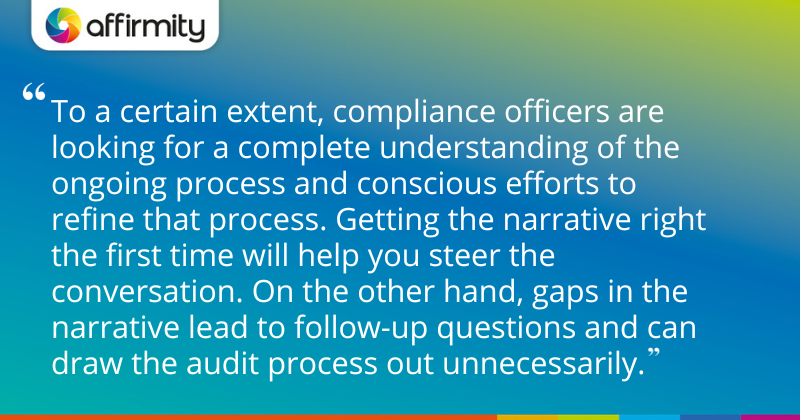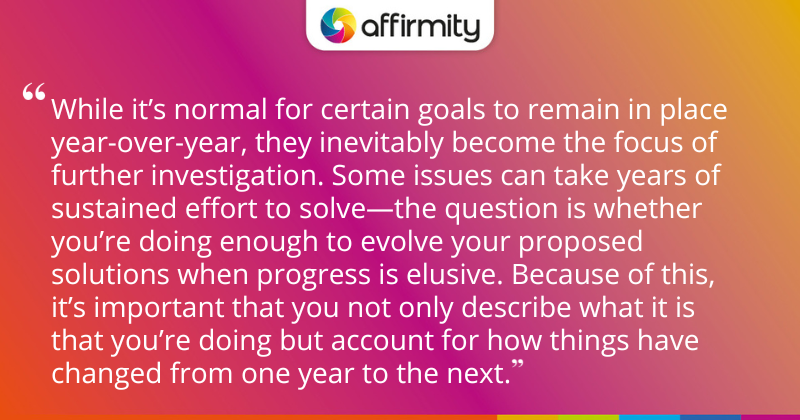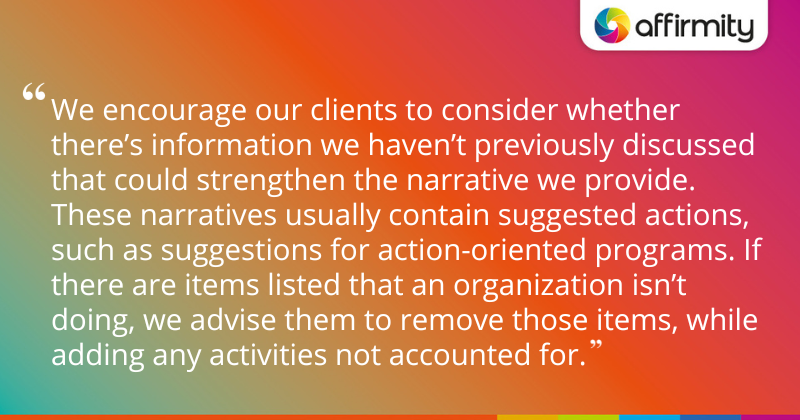Sharp-witted organizations are always looking for ways to “control the narrative.” When the OFCCP selects one of your locations for an audit, you quite literally have control over how your efforts are framed and described through your affirmative action plan narratives. Read on to discover what these narratives include, why they’re important, and how you can shape them to ensure that good work isn’t overlooked.
What Is the Narrative Component of Your Affirmative Action Plan?
While a lot of the evidence you submit to the OFCCP is statistical, a portion of your AAP is written. This narrative component must describe the activities you conduct to meet AAP goals. In broad terms, it should cover:
-
- Designation of responsibility: you must identify an executive who has the authority and resources to ensure that the AAP is put into practice.
- Identification of problem areas: looking at your total employment process, you’re expected to indicate where impediments to equal employment opportunity exist. You must also identify concentrations and absences of any specific protected group within your workforce.
- Description of corrective action-orientated programs: this includes who is responsible, what actions will be taken, and when and how the program will work. If procedures have previously produced inadequate results, contractors are expected to adapt their approach.
- Explanation of internal audit schedule: you must explain how you have designed and implemented reporting systems and periodic internal audits capable of measuring the effectiveness of your AAP.
Furthermore, there should be separate narratives for minorities/females, veterans, and individuals with disabilities. Each should individually cover the points above.

Why Is Your AAP Narrative Important?
In short, the AAP narrative is your opportunity to describe what you need to address, the measures you’re taking, and the organizational and process structures in place to ensure equal employment opportunity is continuously monitored and acted upon.
While the AAP narrative has sometimes seemed more of a checkbox item during the OFCCP’s auditing process, the Affirmity team has noted a sharp increase in questions from compliance officers on the topic in recent years. For example, an organization that had no female representation in a specific job group was asked by a compliance officer to provide additional language connected to its remedial outreach efforts.
To a certain extent, compliance officers are looking for a complete understanding of the ongoing process and conscious efforts to refine that process. Getting the narrative right the first time will help you steer the conversation. On the other hand, gaps in the narrative lead to follow-up questions and can draw the audit process out unnecessarily.
LEARN HOW TO ALLY YOUR NARRATIVE WITH STRONG DATA | ‘How to Help Your Affirmative Action Data Reach Its Full Potential’
4 Important Actions for Your AAP Narrative
Bearing in mind the importance of this narrative and current trends among what OFCCP compliance officers are asking, we’ve assembled a list of four actions you’ll want to pay particular attention to:
1) Devote Extra Time to Describing Outreach Efforts
Judging by the kinds of questions that are coming through to auditing clients regarding their narratives, the OFCCP has become increasingly focused on outreach efforts. They’re looking for proof that organizations are doing what they say they’re doing. Therefore, it makes a lot of sense for organizations writing narratives to redouble their efforts to describe their outreach plans in detail—what they’re currently doing, what their plans are, whether they have placement goals, and so on.
OFFCP auditors are looking for answers to the questions like those below. They expect to see these answers for each individual item, and for the overall program in a particular area.
- How many people did you interview?
- How successful was the outreach method?
- How did you measure that success?
It’s not enough that the data exists to answer these questions. Your narrative must address them, and you should also expect to address minorities/females, veterans, and individuals with disabilities. Consider going into more depth than you usually would—we’ve seen some instances of compliance officers going into the fine detail of processes such as hiring and compensation, particularly if goals have repeated year-over-year.
FROM OUR OFCCP COMPLIANCE VIDEO SERIES | ‘OFCCP Compliance Series: Build Your Good Faith Efforts Program’

2) Account for Your Evolving Approach to Repeating Goals
While it’s normal for certain goals to remain in place year-over-year, they inevitably become the focus of further investigation. Some issues can take years of sustained effort to solve—the question is whether you’re doing enough to evolve your proposed solutions when progress is elusive.
Because of this, it’s important that you not only describe what it is that you’re doing but account for how things have changed from one year to the next. Perhaps in a certain period you tried one thing, but your measurement showed it wasn’t working. Therefore, you describe that going forward you’re adapting your approach in certain ways to find a working solution.
This requirement highlights the importance of having a robust account of everything you try that you can refer back to. Otherwise, you will only be able to describe your current efforts—which risks letting compliance officers assume that your approach hasn’t changed for as long as you’ve had the goal.
3) Ensure Your Policy Statements Are Letterheaded
One other detail that bears mentioning is that in the event of an audit, you will need to submit your equal employment statement along with your veterans and individuals with disabilities narratives. Furthermore, your EEO policy statement should be provided on letterhead, and needs to be signed in order to be validated. Failure to include the statement as directed may result in follow-up questions.
MORE ON THE OFCCP AUDITING PROCESS | ‘How to Prepare Your Employees for On-Site Visits From OFCCP Auditors’

4) Read and Re-Read Your Narrative
In the process of writing your narrative you’ve doubtlessly read and re-read it several times, so this last point may seem a little odd. However, we say it to encourage you to check with a fresh pair of eyes (and perhaps with a colleague’s fresh pair of eyes too!) that the narrative definitely covers everything you’re doing and that you’re looking to do.
When clients work with us for OFCCP audit support services, we encourage them to consider whether there’s information we haven’t previously discussed that could strengthen the narrative we provide. These narratives usually contain suggested actions, such as suggestions for action-oriented programs. If there are items listed that an organization isn’t doing, we advise them to remove those items, while adding any activities not accounted for.
Finally, you’ll want to double-check that your narrative isn’t implying or outright stating you’re taking actions that you’re not actually taking—whether those are positive or negative.
Discover how Affirmity can help you prepare for affirmative action planning and audit activity: check out our Affirmative Action Plan services or contact us for more information.
 About the Author
About the Author
Stephen Caldwell is a Manager of Consulting Services and Diversity Planning Programs at Affirmity. In this role he leads and manages a team of Affirmity consultants, providing consulting and project management in diversity planning. He has assisted clients in the utility, healthcare, defense, telecommunications, energy, chemical, and other industries.
Mr. Caldwell has been with Affirmity for more than eight years and has over 20 years of experience in human resource consulting and diversity planning.
